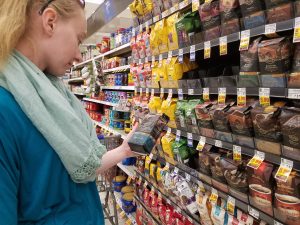
All food products have five standard components regulated by the FDA.
Each time you enter a supermarket, you are faced with nearly 40,000 products to choose from[1]. Each product brightly colored, strategically placed and wordsmithed perfectly to convince you not to leave the store without it. So, how as consumers can we decipher all the information food packages provide and use it to make better purchasing decisions for our families? We have to learn the food label lingo. First, it is important to recognize that all food products have five standard components regulated by the Food and Drug Administration (FDA).
- Product Identity (product name that accurately describes the package contents)
- Net Content (product quantity or weight)
- Nutrition facts
- Ingredients/ allergen statement
- Signature Line (including company name and address of the manufacturer or distributor)
But most packages contain a slew of additional information that highlights anything from farm practices, to health benefits, to social and economic practices. There are three possible origins of food label claims and statements, 1) government agencies like the USDA and FDA; 2) third-party organizations like American Grassfed®, Non-GMO Project Verified, Fair Trade Certified, and Certified Angus Beef®; and 3) food manufacturers or producers.
 Government issued labels were created to: ensure fair competition among producers, provide consumers with basic product information, and most importantly to reduce health and safety risks[2]. Government labels always have the agency from which the standards originate listed, for example USDA organic or Dolphin Safe, United States Department of Commerce. Government standards and record of companies holding their certifications can be accessed online or by contacting the respective agency.
Government issued labels were created to: ensure fair competition among producers, provide consumers with basic product information, and most importantly to reduce health and safety risks[2]. Government labels always have the agency from which the standards originate listed, for example USDA organic or Dolphin Safe, United States Department of Commerce. Government standards and record of companies holding their certifications can be accessed online or by contacting the respective agency.
Third-party labels were created to enhance the intelligibility and credibility of certain food attributes through the use of standards, verification, certification, and enforcement[2]. Each organization is responsible for determining their own set of standards that producers must follow to use their trademarked seal. Third-party labels can vary from very strict standards that require yearly audits to very loose standards that are more like a subscription with no verification process. I encourage consumers to do additional research on labels they think align with their values to ensure they match.
Lastly, producers and manufacturers create a number of food label claims and statements to entice consumers. A few of the more current statements include: natural, 100% pure, all, made with real fruit, made with whole grains, lightly-sweetened, a good source of fiber, local, and strengthens your immune system[3]. Be wary of these statements because they are unregulated and defined entirely by the manufacturer.
To learn more, visit my website Understanding Food Labels. Here you will find hundreds of food labels, videos and educational resources that can be used in Extension program efforts.
Resources:
[1] Food Marketing Institute. (2017, November 13). Supermarket Facts. Retrieved 2017, from https://www.fmi.org/our-research/supermarket-facts
[2] Golan, E., Kuchler, F., & Mitchell, L. (2000). Economics of Food Labeling. Washington: Economic Research Service, U.S. Department of Agriculture. Retrieved from https://www.ers.usda.gov/webdocs/publications/41203/18885_aer793.pdf?v=41063
[3] Silverglade, B., & Heller, I. R. (2010). Food Labeling Chaos. Washington, DC: Center for Science in the Public Interest. Retrieved from https://cspinet.org/sites/default/files/attachment/food_labeling_chaos_report.pdf
 Carol Hamilton is an Extension Educator (Delaware County).
Carol Hamilton is an Extension Educator (Delaware County).